Pep Guardiola Coaching Philosophy
High performance does not come from boasting or comparing oneself to others; it’s about being your best self and constantly striving to improve.
Pep Guardiola is a prime example of this mindset as he consistently develops his style and incorporates new ideas into his philosophy, regardless of their origin.
His ability to select and develop individuals to fit a range of tactics sets him apart, while his passion for improvement and winning is unwavering.
Unquestionably, one key ingredient distinguishing the Catalan coach from others is his passion for consistently developing and the permanence of winning.
An example of Guardiola’s adaptability is seen in his use of the double pivot, inspired by Roberto De Zerbi‘s approach.
Guardiola utilised this tactic and developed it further under his positional play principles, gaining superiority across the pitch.
“The best team at making the build-up in the world is Brighton! There is no team better that make the process to get the goalkeeper to bring the ball into to the last quarter.” — Pep Guardiola
Teams have tended to press high, thus the popular tactics put more emphasis on building from the back.
It was common and widespread that rely on the double pivot limiting build-up — something that even Johan Cruyff spoke about.
Therefore, a single-pivot is used a lot during the build-up phase.
This tactical analysis piece will explore Guardiola’s build-up phase theoretically, how it has rejuvenated Manchester City‘s style after relying on the 3-2-2-3 formation and how they can be pressed.
Pep Guardiola Tactics & Man City Formations
Regarding deeper build-up, teams often use six or seven players, including the goalkeeper, to build from the back against high-pressing approaches, be they zone-oriented, hybrid, or man-oriented.
The goalkeeper is usually considered a pressing trigger because he is typically the less gifted player in this phase.
Building from deeper areas means having an additional player, a +1, as the goalkeeper is included.
As a result, teams tend to try and acquire a goalkeeper skilled in ball control and technical abilities such as passing range, accuracy, vision, and awareness to make effective decisions.
It is also crucial for a ball-playing goalkeeper to possess confidence and quick reflexes under pressure.
They must be capable of directing play to a less pressured area or potentially less pressured one on the field.
Ederson is a prime model of the skilled ball-playing goalkeeper who is not typically considered a pressing trigger, so Pep relies on him heavily.
“Futsal really helped with that.
You must be calm, make the right decisions, pick the right passes.
Because it is a small-sided pitch, you are playing under pressure often, which helps me as a player even today.
It makes that feeling of calmness more natural.” — Ederson
After transitioning from 4-3-3 to 3-2-2-3, Ederson became an even more important element of City’s early possession play in the 4-2 setup.
The two wide centre-backs move out to become the full-backs and the central centre-back alongside the goalkeeper while a double-pivot is deployed in front of them.
It is common for pressing teams to block the depth and try to direct the play towards one side, where they can apply pressure (a pressing trap).
This is because the ball carrier typically has fewer passing options and a bad angle of vision when playing towards the sidelines.
In the below graphic, in 4-3-3, when the player on the ball receives, it’s relatively easy for the opponent’s winger to press them while also blocking the passing lane to the centre-back and goalkeeper.
However, in 3-2-2-3, Man City are operating a 4-2 base with two defensive midfielders positioned at different heights, diversifying the central passing options.
This makes them much more difficult to press at this deeper point, especially given the quality of their players.
In various pressing schemes and formations, the pressing team leave the ball-far full-back free to prevent numerical superiority.
This is because the passing angle to him is very difficult to exploit.
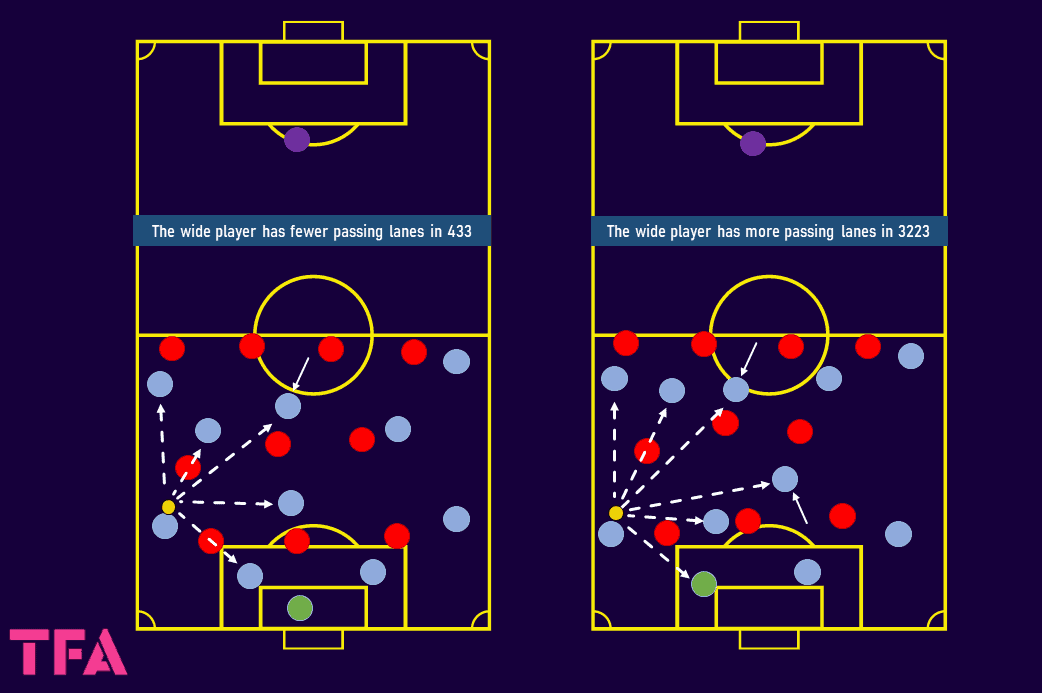
At that moment, Man City would have two attacking midfielders positioned to create a box midfield with the defensive midfielders, a striker ready to drop off, and high and wide wingers pinning the backline.
In contrast to 4-3-3, the 3-2-2-3 allows even one or two players of the front five to drop to support, while there are three that can exploit the spaces if the backline defenders are provoked to get out or be in 1v1 situations.
This can create a potent mix of numerical, positional, qualitative, and dynamic superiority.
Therefore, most teams have tended lately to delay the pressure around 30 meters from the goal to prevent the Citizens from having +1 (Ederson) during this phase.
Man City takes in the recent shape 3-2-2-3.
Ederson becomes a safe option to recirculate or a trigger to provoke the opponent to move higher to press and then exploit the spaces between their lines.
Immediatel,y Man City look for high-tempo progression through the centre or the flanks.
Still, the deep midfielders remain at different heights to create triangles and quickly move in the blindside of the first line of opposition pressure to open up the lanes (third-man combinations play).
Meanwhile, the centre-backs often take a momentary pause or delay before releasing the ball, forcing the opposition’s pressing players to commit to a particular direction or action, creating spaces.
If the depth is locked, they look for progress from the wide zones by dropping one of the attacking midfielders (De Bruyne and Gündoğan) while the opposition’s full-backs are pinned higher by the wingers (Grealish and Mahrez).
In 4-3-3, Man City used to occupy the spaces of the full-backs (4-1) and then dynamically shift to 3-2/2-3 based on the pressure they faced.
Now, with the 3-2-2-3, the central presence (3-2) has become static, thus allowing for the dynamic exploitation of the full-back zones through the attacking midfielders or the wide progressor.
For example, John Stones is not an inverted RB but rather a direct defensive midfielder who returns to a right-back or centre-back position, out-of-possession, based on defensive decisions.
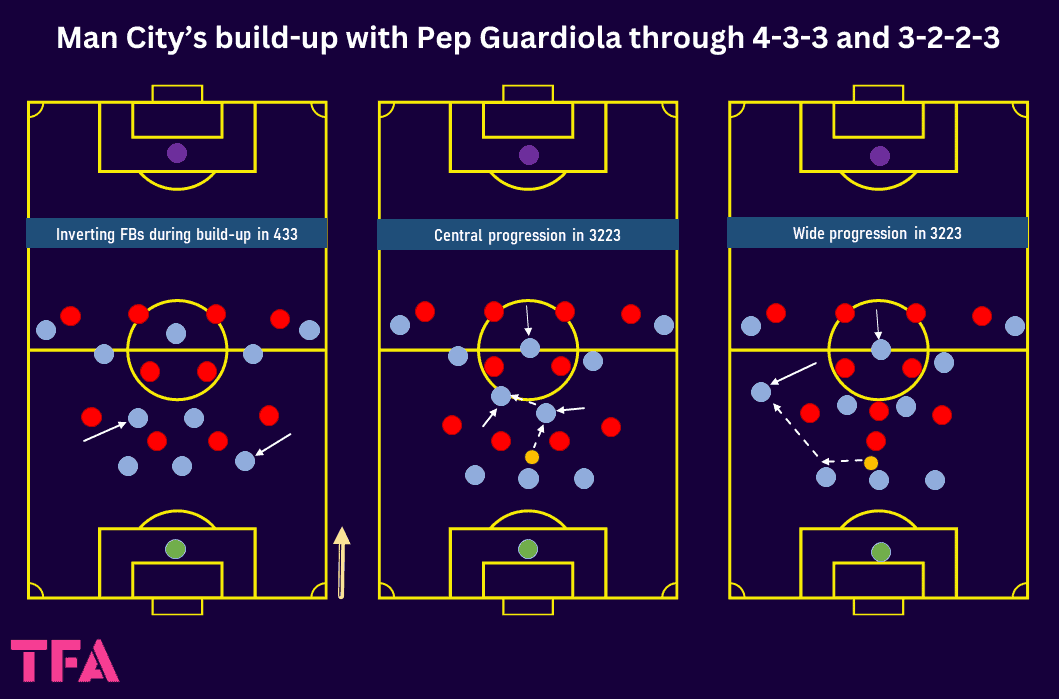
Usually, the man-to-man pressure can be difficult to build against, though it’s risky for the pressing team because of vulnerability in one-on-one situations, fatigue, overlapping runs, and exposure to space, forcing goalkeepers to play long balls.
In the scenario that the below graphic references, Ederson is forced to play long-ball for the striker or winger in the space where it is 3v3 with the possibility of 5v3 due to the high positioning of the attacking midfielders who can potentially win the second balls due to the positional superiority and dynamic superiority over their markers.
To further enhance their attacking options against five-player backline structures, Pep has employed a dynamic 3-1-3-3 (3-1-6) setup, which creates a 6 vs 5 numerical advantage against the opposition backline, with one of the attacking midfielders dropping off alongside Rodri when needed to create 2-2 instead of a 1-3 — a dynamic box-midfield.
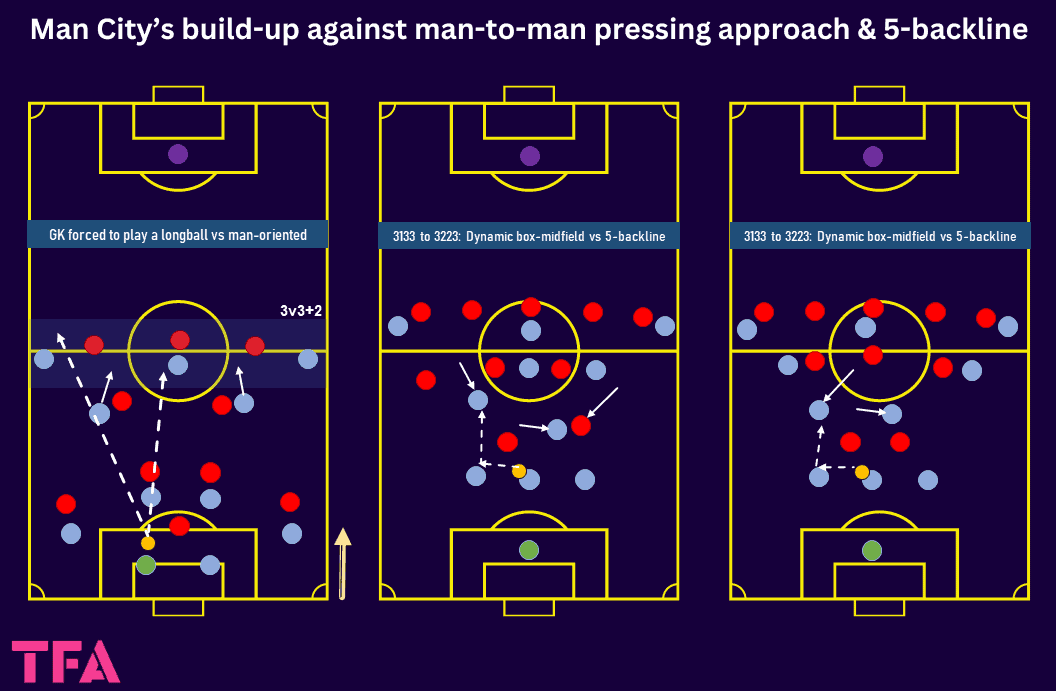
As mentioned, John Stones is not an inverted full-back — a role we’ve seen City use a lot in the past — but rather directly a defensive midfielder in all in-possession phases who shifts back out-of-possession to a right-back or a centre-back.
His transition, for example, directly to centre-back against Bayern Munich, with Manuel Akanji moving to right-back, reduced the risk of diagonal runs during the defensive transitions.
Additionally, having four centre-backs in the rest defence (3-2) and set-pieces is a nice benefit.
Before diving into the next section, it should be said that positional play is always searching for superiorities, not consisting of horizontal or vertical passing.
Therefore, the tempo of the game is controlled by the team’s desire to achieve these superior qualities.
Pep Guardiola’s Man City has been emphasising high-tempo progression.
It’s one moment of transitioning quickly from their normal tempo to a higher one.
How to press Against Manchester City
“Success is not final, failure is not fatal: it is the courage to continue that counts.” — Winston Churchill
What is the most effective method of pressing Man City during their build-up phase?
The significant threat of City’s build-up lies in the box midfield, and the presence of Ederson in this way allows for more efficient progression with fewer players.
This also allows for the 8s to be more involved in the last line.
So, if they are left unmarked, De Bruyne and Gündoğan create big chances.
Teams have recently, at the time of writing, adopted narrow positional approaches against Man City’s build-up, examples include Bayern Munich‘s 4-2-3-1 scheme and Southampton’s 4-2-4 scheme, due to the disadvantageous -2 situation in the first third of the press.
The strategy involves directing play to the sidelines and pressing the full-back or winger, as illustrated in the accompanying graphics.
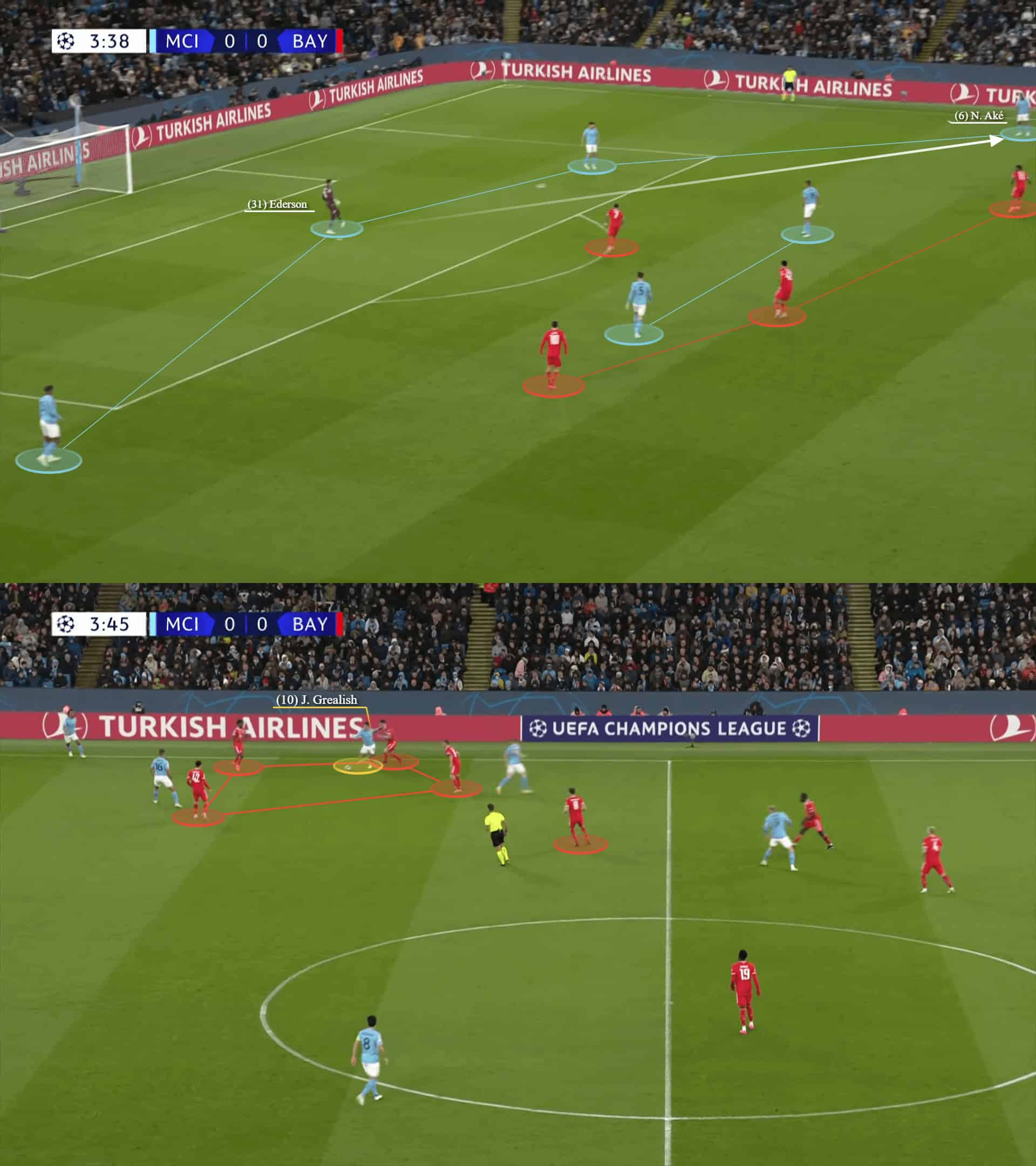
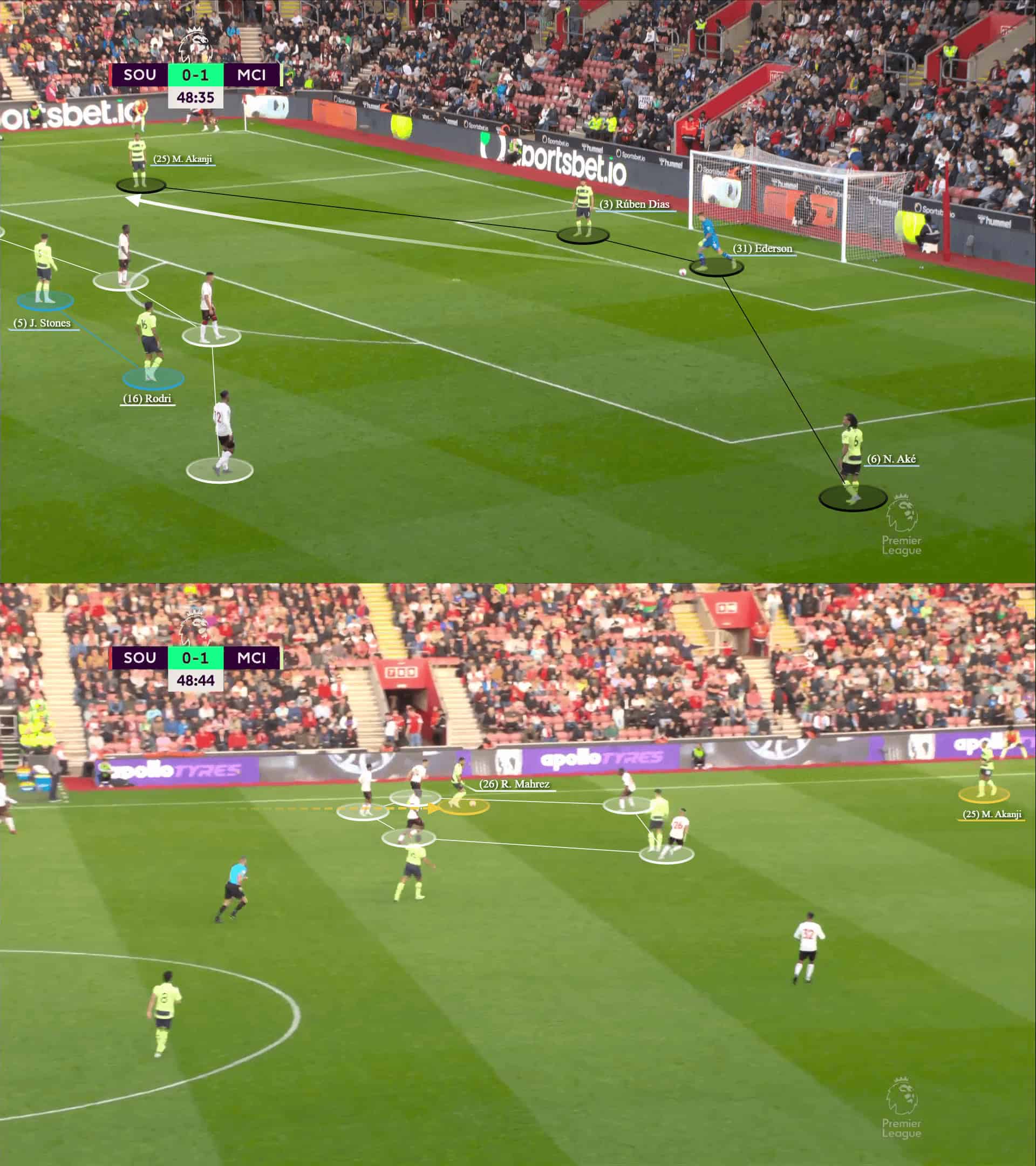
One potential downside to this approach becomes evident if Man City can bypass the press or trap and increase the tempo.
This can lead to a quick switch of play to the reverse attacking midfielder who is left unmarked.
This creates a 2v1 situation against the opposing full-back, resulting in positional, numerical, and dynamic superiorities, which can leave the last line of defence vulnerable, as we see in the graphic below.
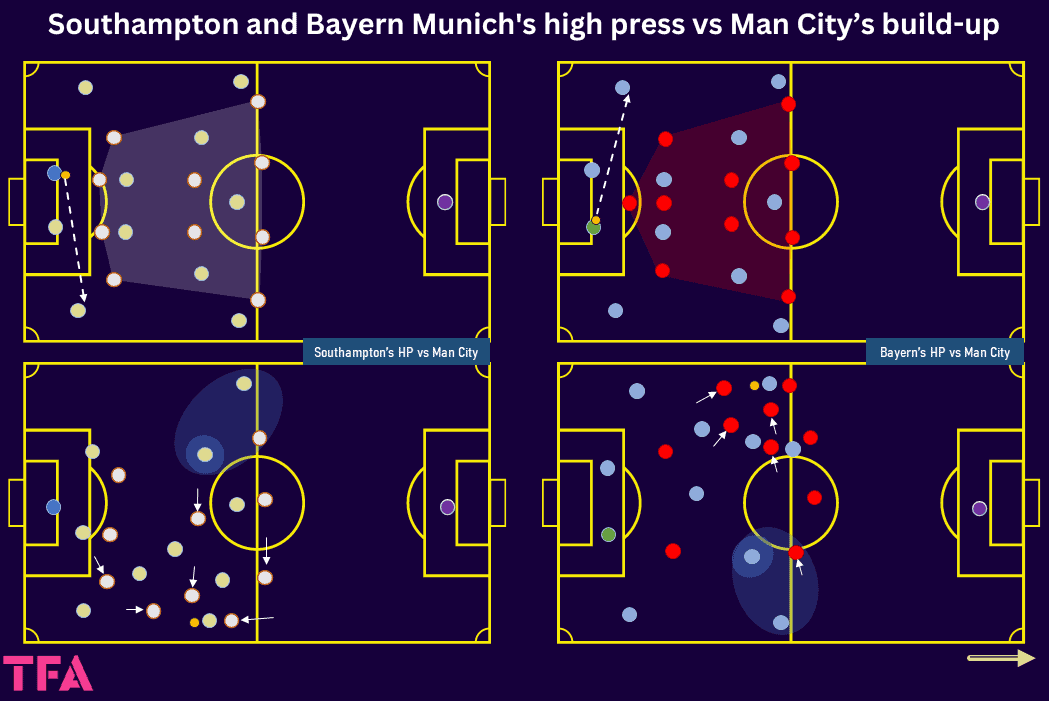
Here, if the winger (Mahrez or Grealish) receives the previous slide pass from the centre-back with a less-than-optimal body shape, it is an opportune moment for the pressing team to quickly apply pressure.
Based on the potential danger, it is recommended to adopt a pressing scheme that focuses on tightly marking the entire box midfield (static and dynamic markers) while maintaining a balanced pressing structure.
The graphic below illustrates the proposed pressing scheme, which is a narrow hybrid 4-1-4-1.
The approach involves having a player in the first line ready to press the goalkeeper and the central centre-back immediately to force the play wide.
Two players mark the defensive midfielders tightly, while two players in the half-spaces position themselves as close as possible to City’s attacking midfielders.
This enables them to close down the passing lanes to them and be ready to press the side centre-backs diagonally once the ball reaches one of them.
While the centre-backs contain the striker, the holding midfielder operates as a shield player, covering the area positionally to protect the space from any possible drop-off striker and presses City’s ball near ‘8’.
In contrast, another midfielder returns to mark the other ‘8’.
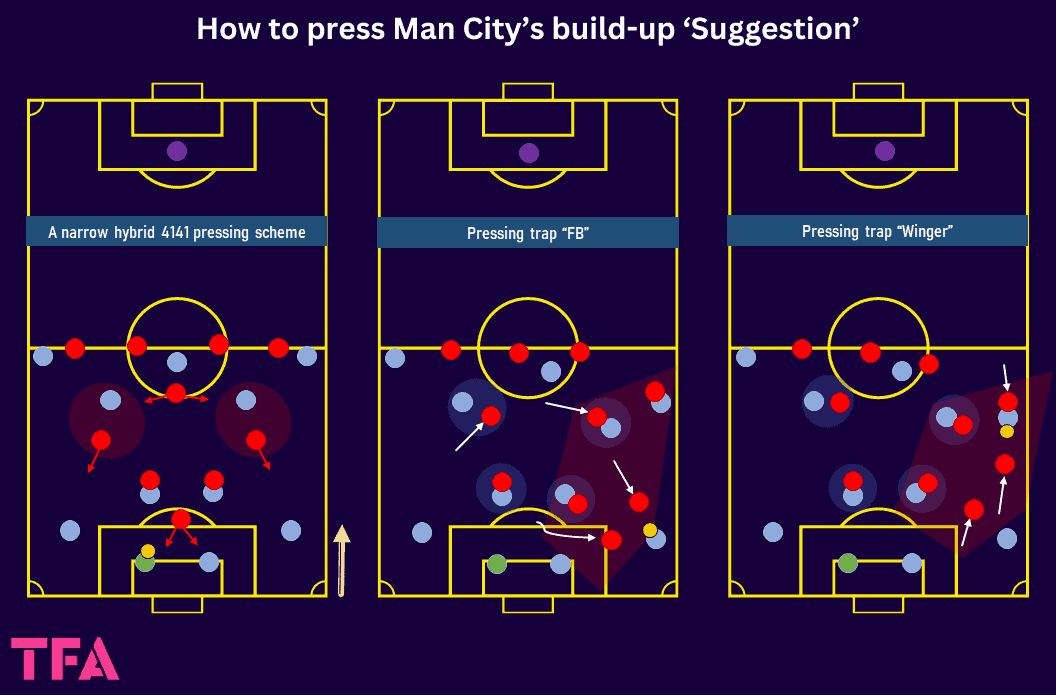
Conclusion
“We have an Italian coach here, he’s called Roberto De Zerbi, and he’s changing many things in English football, playing marvellous football, and doing incredibly well.” — Pep Guardiola
This analysis explores Pep Guardiola’s build-up phase theoretically and how it reactivated Manchester City’s style, as well as how to press them.
The article discusses how Guardiola developed his style, his passion for improvement and winning, and how he has incorporated new ideas into his philosophy.
How Pep Guardiola smoothly copies ideas without arrogance and develops them!





Comments